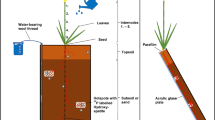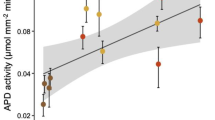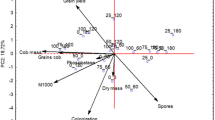Abstract
INVESTIGATIONS based on chemical analyses have indicated that the absorption of phosphorus by pine seedlings is increased by the presence of ectotrophic mycorrhizas1. Harley et al. 2 have shown, however, that when labelled phosphorus is supplied to excised roots of beech the presence of a mycorrhizal sheath presents a partial barrier to phosphorus uptake by the tissues of the root. This communication reports the result of an experiment in which phosphorus-32 was used to indicate how far the mycorrhizal habit influences the uptake of phosphorus by intact plants of Nothofagus menziesii (mycorrhizas ectotrophic, typical of the Fagaceae) and Pinus radiata. The presence of mycorrhizas had no apparent effect on the rate of growth of these two species under the conditions employed in the experiment.
This is a preview of subscription content, access via your institution
Access options
Subscribe to this journal
Receive 51 print issues and online access
$199.00 per year
only $3.90 per issue
Buy this article
- Purchase on Springer Link
- Instant access to full article PDF
Prices may be subject to local taxes which are calculated during checkout
Similar content being viewed by others
References
Hatch, A. B., J. Forestry, 34, 22 (1936). Mitchell, H. L., Finn, R. F., and Rosendahl, R. O., Black Rock Forest Papers 1, 58 (1937).
Harley, J. L., and McCready, C. C., New Phytol., 51, 56 (1952). Harley, J. L., Brierley, J. K., and McCready, C. C., New Phytol., 53, 92 (1954).
Author information
Authors and Affiliations
Rights and permissions
About this article
Cite this article
MORRISON, T. Uptake of Phosphorus-32 by Mycorrhizal Plants. Nature 174, 606–607 (1954). https://doi.org/10.1038/174606a0
Issue Date:
DOI: https://doi.org/10.1038/174606a0
This article is cited by
Comments
By submitting a comment you agree to abide by our Terms and Community Guidelines. If you find something abusive or that does not comply with our terms or guidelines please flag it as inappropriate.



